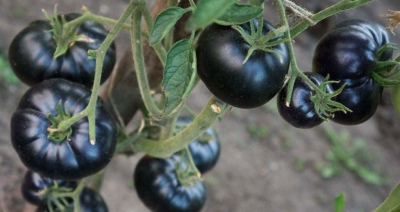
- Authors: Brad Gates, USA
- Appeared when crossing: Berkeley tie dye Pink x Indigo apple
- Name synonyms: Black Beauty, Black Beauty, Black Beauty, Black Beauty
- Category: grade
- Growth type: indeterminate
- Appointment: fresh consumption
- Ripening period: mid-season
- Growing conditions: for greenhouses
- Bush size: tall
- Bush height, cm: 200
You can decorate a garden bed in a greenhouse, as well as feast on unusually tasty black and purple tomatoes throughout the summer by choosing the Black Beauty variety of American selection for growing.
Breeding history
Black Beauty is an exotic creation by American breeder Brad Gates. The nightshade crop was bred in 2015, not included in the State Register for the Russian Federation. Several tomato species were used when crossing - Indigo Apple and Berkeley tie dye Pink. Productive culture when grown in greenhouses.
Description of the variety
The Black Beauty tomato is an indeterminate plant that can stretch up to 200 cm in height. The tall bush is characterized by medium branching, a strong central stem with a pronounced edge, moderate thickening with dark green leaves, a developed deep root system and simple inflorescences. On a healthy bush, 8-9 fruit clusters are formed with 4-6 tomatoes in each.
During cultivation, it is necessary to form bushes of 1-3 stems, remove unnecessary stepsons and tie them to supports or trellises. Thanks to their versatility, tomatoes are not only eaten fresh, but processed into drinks and dressings, pickled and canned. The smallest fruits are suitable for canning.
The main qualities of the fruit
Black beauty is a medium-fruit type of tomato, weighing from 100 to 150 grams. The fruit has a flat-round shape without ribbing, an unusual black or dark purple color in a state of full ripeness and a glossy surface. In a state of technical maturity, tomatoes have a deep red color, which gradually changes. The tomato skin is firm, but not tough. The vegetable is resistant to cracking, tolerates transportation well and is stored for a long time without loss of useful, taste and marketability. A feature is that the longer a vegetable is stored, the tastier it becomes.
Taste characteristics
The taste, like the appearance of the vegetable, is very attractive. The flesh of the fruit is fleshy, oily, moderately firm and very juicy. At the break, the flesh is dark red. The taste is dominated by bright sweet notes. Seeds are practically not observed in the pulp, but vitamins and antioxidants are present in huge quantities.
Ripening and fruiting
The variety is mid-season. From the moment of mass germination of sprouts to the first ripe tomatoes on the bushes, 105-110 days pass. The fruiting period is extended, so you can enjoy fresh tomatoes until frost. The first tomatoes can be tasted in mid-July. Under favorable conditions, the bushes can bear fruit from July to mid-September.
Yield
The crop yield is very high. If all agrotechnical rules are fulfilled, up to 9 kg of exotic tomatoes ripen per 1 m2. Up to 4-5 kg of berries can be removed from one bush grown in a garden in the southern strip of the country.
The timing of planting seedlings and planting in the ground
The plant is planted through seedlings. You can sow seeds from late February to the second half of March. The seed is pre-sorted and disinfected. It is better to use a purchased one as a primer. Seed germination occurs on the 5-7th day.If desired, for better germination, the box with seeds is covered with polyethylene or glass. As soon as the plant has 2-3 leaves, they dive. For healthy growth and development, plants should be provided with the correct temperature regime (20-24 degrees) and a sufficient amount of light. Bushes need to be watered and fed with fertilizers. A week before transplanting, it is recommended to prepare the seedlings - harden them daily, exposing them to fresh air.
The bushes are transferred at the age of 45-60 days. In the greenhouse, planting is carried out in early May, and on the garden bed - two weeks later.

Growing tomato seedlings is an extremely important process, because it largely depends on whether the gardener will be able to harvest at all. All aspects must be taken into account, from seedbed preparation to planting in the ground.
Landing scheme
The planting density of seedlings is very important, since it depends on whether the plant receives the sun and air in the right amount. It is recommended to place 3 bushes per 1 m2. The correct scheme for planting is considered to be a 40x50 cm scheme.

Growing and care
The variety is completely unpretentious in maintenance, but the soil should be loose, fertile, moisture-permeable and breathable. The best will be the area where greens or zucchini previously grew. In addition, the site should be well lit by the sun.
Caring for tomatoes includes watering with warm water under the root, fertilizing 2 times a month, forming and tying bushes, removing stepchildren, ventilating the greenhouse, as well as protecting against insect and fungus infestations.




A plant needs different micronutrients at each stage of growth. All fertilizers can be divided into two groups: mineral and organic. Folk remedies are often used: iodine, yeast, bird droppings, eggshells.
It is important to observe the rate and period of feeding. This also applies to folk remedies and organic fertilizers.
Disease and pest resistance
The culture is highly resistant to diseases, so it rarely undergoes standard diseases of the nightshade - tobacco mosaic virus, apical rot, fusarium wilting.Tomato's resistance to late blight is average, so preventive treatments are welcome.
Resistant to adverse conditions
Stress tolerance in tomato is moderate. He easily tolerates drought or heat, but does not really like shade.



























































































